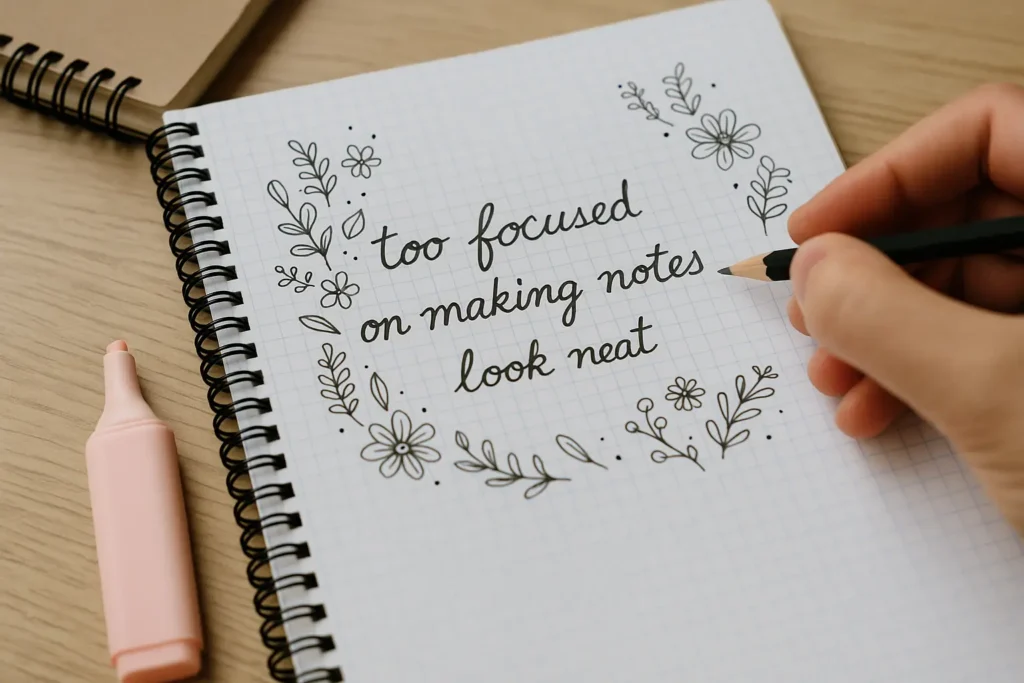
One of the most common traps that exam candidates fall into is the illusion of productivity. You may sit at your desk for hours, highlight notes, watch videos, or take pages of handwritten summaries — but at the end of the day, little has actually been learned. This is what we call “fake studying” — when the effort feels real, but the results are minimal.
Fake studying is dangerous because it gives the impression of progress. You feel busy, maybe even exhausted, but your retention, understanding, and performance don’t improve. Over time, this leads to frustration, burnout, and eventually the belief that you’re “not good enough,” when the problem is simply your study approach.
In this article, we’ll help you identify the most common signs of fake studying, understand why they happen, and show you how to eliminate them from your routine. If you want real results, you need to stop studying for appearances — and start studying for efficiency.
What Exactly Is Fake Studying?
Fake studying refers to any activity that looks like learning but doesn’t actually help you internalize content or improve your performance on the exam. It often involves passive techniques, repetitive routines, or excessive note-taking without real engagement with the material.
Examples include watching long video lessons without taking notes or solving questions, copying entire textbook pages without processing the content, or highlighting everything in a book without reflecting on what’s truly important. These actions feel productive because they require time and energy — but they often lack cognitive effort.
Real studying involves active recall, problem-solving, and spaced repetition. It’s not about how much time you spend — it’s about how deeply you engage with the content. The more your brain is challenged, the more meaningful and lasting the learning becomes.
Sign #1: You’re Studying for Hours But Retaining Very Little
A clear indicator of fake studying is when you spend a lot of time with your materials, but you can’t recall the information later. If you read a chapter in the morning and can’t explain it by the afternoon — or if you forget everything a week later — something’s wrong with your method.
This usually happens when you’re using passive techniques. Reading and re-reading, for instance, may feel like you’re learning, but without testing yourself, the content doesn’t stick. The same applies to watching lessons passively or copying notes without reflection.
To fix this, apply active recall regularly. After studying a topic, close the book and try to explain it out loud, write a summary from memory, or quiz yourself. This forces your brain to retrieve information — which strengthens memory and reveals gaps in understanding.
Sign #2: You Focus More on Aesthetics Than Learning

Many students fall into the trap of trying to make their study materials look beautiful — color-coded notes, perfect handwriting, well-decorated summaries. While organizing your material can help to some extent, spending too much time on presentation often means you’re avoiding real engagement.
Ask yourself: Are you re-writing notes just to feel productive? Are you spending hours making flashcards but never reviewing them? Are you choosing highlighters over hard questions? If so, you might be studying for validation, not for results.
The solution is to shift your focus from how your study looks to how much you understand. Use messy, fast summaries if they help. Focus on utility over appearance. Your goal is not to impress anyone with your notebook — your goal is to pass the exam.
Sign #3: You Avoid Questions and Real Exam Practice
Fake studying often means avoiding practice questions, mock exams, or timed challenges. Many students postpone these tasks because they’re uncomfortable — they reveal weaknesses and require mental effort. But that’s exactly why they’re essential for progress.
You might feel like watching a three-hour class is enough. But without testing what you learned, you’ll never know if the information truly stuck. Solving questions is not just evaluation — it’s part of the learning process. It helps you identify patterns, spot frequent errors, and simulate the exam environment.
If you’re spending more time passively consuming content than actively applying it, your study routine needs urgent correction. Include daily or weekly practice sessions, and treat mistakes as learning opportunities, not failures. That’s how real improvement happens.
Sign #4: You Don’t Have a Clear Goal for Each Study Session
Another sign of fake studying is sitting down with your books or computer without a clear objective. You tell yourself you’ll “study Portuguese” or “review Law” — but without knowing what specifically you’re trying to accomplish, your focus drifts, and your session becomes unproductive.
High-performance students start each session with specific, measurable goals: “I’ll review 10 Civil Law questions and understand my mistakes,” or “I’ll summarize the key points from today’s class and test myself.” This kind of clarity keeps your brain active and focused.
To make your study more effective, write down a goal before each session, track what you completed, and reflect on what you learned. When your study has purpose, your time produces results — not just effort.
Sign #5: You Study Without Reviewing or Revisiting Content
A major contributor to fake studying is ignoring review cycles. You study a subject once and move on, assuming you’ll remember it. But memory doesn’t work that way. Without spaced repetition, most of what you learn is forgotten within days or weeks.
If you never go back to your notes, never solve questions from past topics, and never test your recall over time, your routine is likely inefficient. You’re creating a false sense of progress by always moving forward — but leaving behind unanchored knowledge.
To fix this, include regular revision blocks in your weekly schedule. Use flashcards, summary questions, or quick reviews of past topics. Reviewing is not optional — it’s what transforms information into lasting knowledge.
How to Build a Real and Effective Study Routine
Eliminating fake studying means replacing it with techniques that actually generate learning. This starts with adopting active methods like:
– Active recall (testing yourself)
– Spaced repetition (reviewing over time)
– Practice questions
– Teaching the content to someone else or out loud
It also involves planning your sessions with intention, measuring progress, and adjusting your approach based on results. Track your performance in mock tests, keep a learning journal, and reflect weekly on what’s working and what’s not.
Finally, avoid multitasking. Real studying demands focus. Don’t check your phone, switch tabs, or split your attention. Study in short, intense sessions — even just 25 focused minutes can be more effective than three passive hours.
Final Thoughts: Don’t Confuse Motion With Progress
Spending time with your books is not the same as learning. Writing notes is not the same as remembering. Watching classes is not the same as mastering the subject. If you want real results, you need to drop the illusion of effort — and embrace what actually works.
The good news is that identifying fake studying is already a big step. Now you can make better choices, use your time more wisely, and build a routine based on learning, not just activity. With discipline, awareness, and the right tools, your effort will finally turn into real progress.
Stop pretending you’re studying. Start making it count.